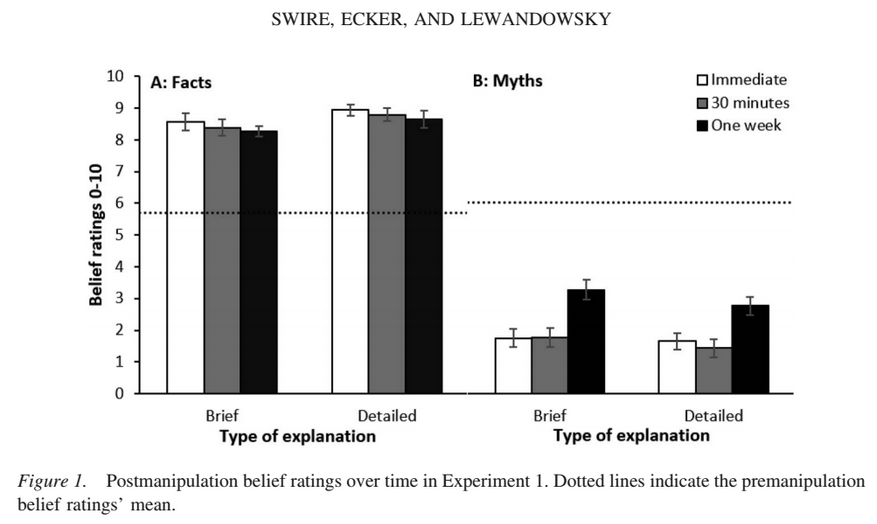You can’t remember all the things you know all of the time, so you rely on some mental shortcuts to get on with life. For instance: You are likelier to think something is true if you’ve encountered it more often.
This phenomenon is known as the “familiarity effect” or “fluency heuristic” and has been documented by a relatively ample body of research.
Last year, a psychologist at Vanderbilt found that reading the sentence “A sari is the skirt that Scottish men wear” twice made people more likely to rate it as true than if they read it only once. Another 2016 study concluded that belief in a statement was “logarithmically related to the number of repetitions.”
In a new study published in the Journal of Experimental Psychology: Learning, Memory, and Cognition, psychologists at the University of Western Australia studied the influence of specific variables on the effectiveness of a correction in light of the familiarity effect. Variables included the age of participants and the level of detail included in the corrective material.
The researchers concluded that more detailed explanations help people remember corrections longer and that individuals over 65 are comparatively worse at holding on to corrective information (i.e. likelier to misremember a myth as a fact).
Researchers used a pilot group to select claims — both true and false — that were “common and at least midrange believable.” They then presented participants with either a brief affirmation/retraction or a more detailed one. The result? Belief in facts shot up while belief in myths tumbled (see table below).
In line with a growing body of research, the psychologists therefore found no evidence of a “backfire effect.”
The effect of the correction on belief in a myth did wear off a little over time, however. “Belief change was more sustained after a fact affirmation compared with myth retraction,” the researchers write, noting that “this asymmetry could be partially explained by familiarity.” It is also worth noting that with over 65-year olds, the regression was significantly higher.

Swire, B., Ecker, U. K. H., & Lewandowsky, S. (2017, May 15). The Role of Familiarity in Correcting Inaccurate Information. Journal of Experimental Psychology: Learning, Memory, and Cognition.
The beneficial effect of a correction was recorded not just when participants were asked explicitly to rate their belief in a claim, but also when these were asked an “inference question.” (For the myth that you can tell if someone is lying through physical tells like eye movement, the inference question was “What percentage of lies can FBI detectives catch just by looking at physical tells?”).
The psychologists believe there are some practical lessons that can be gleaned from their findings.
First, detailed fact checks are more effective. In the study’s case, detailed explanations were a mere three or four sentences long, This is a relatively low bar for fact-checkers to clear. But it does suggest that headlines or tweets alone may not be as effective in correcting a misperception.
Second, fact-checkers may have to repeat their corrections frequently in order to counteract the regression towards thinking a myth is a fact that we experience over time. The study acknowledges this recommendation is “somewhat ironic,” but making a correction more familiar to readers might be worth the drawback of reminding them of the underlying myth.
The study’s conclusions on the use of “inference questions” point to a promising avenue for further study.
“Our inference results mirrored the trend obtained with the belief ratings, demonstrating that familiarity effects can extend to inferential reasoning and potentially decision-making.”
Studies of voters in both France and the United States concluded that fact-checking corrected people’s beliefs but did not reduce their likelihood to vote for the candidate caught lying.
Evaluating the extent to which people will act in a way that is coherent with corrected misperceptions is still a relatively uncertain domain. But at a time of moral panic over “fake news,” it’s definitely an area worthy of further study.







